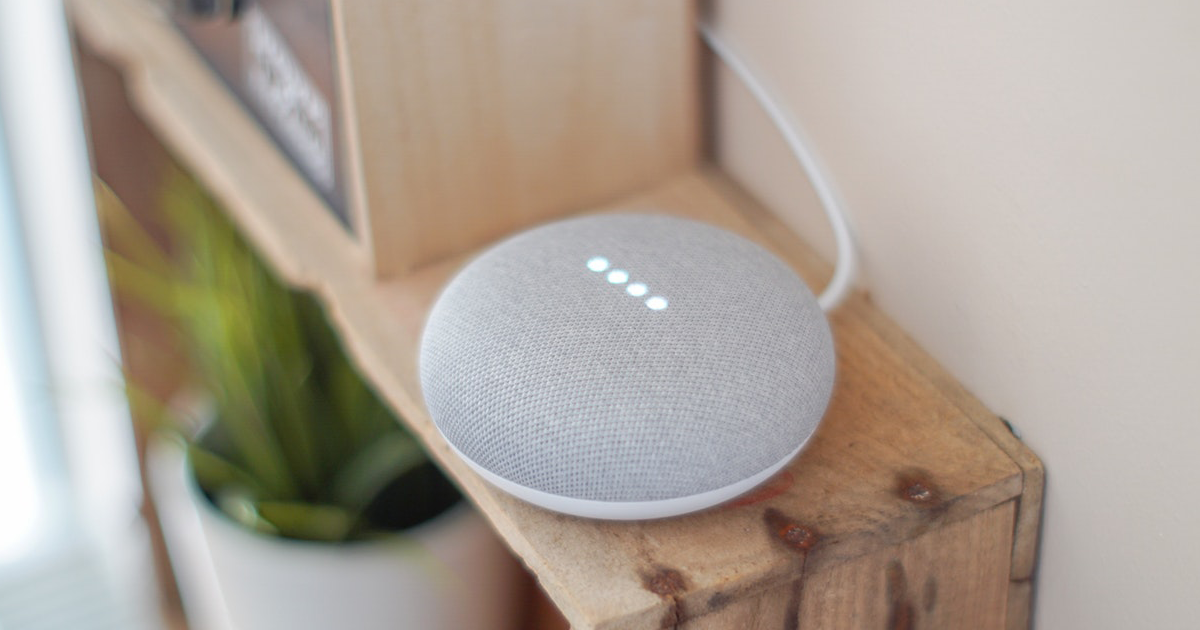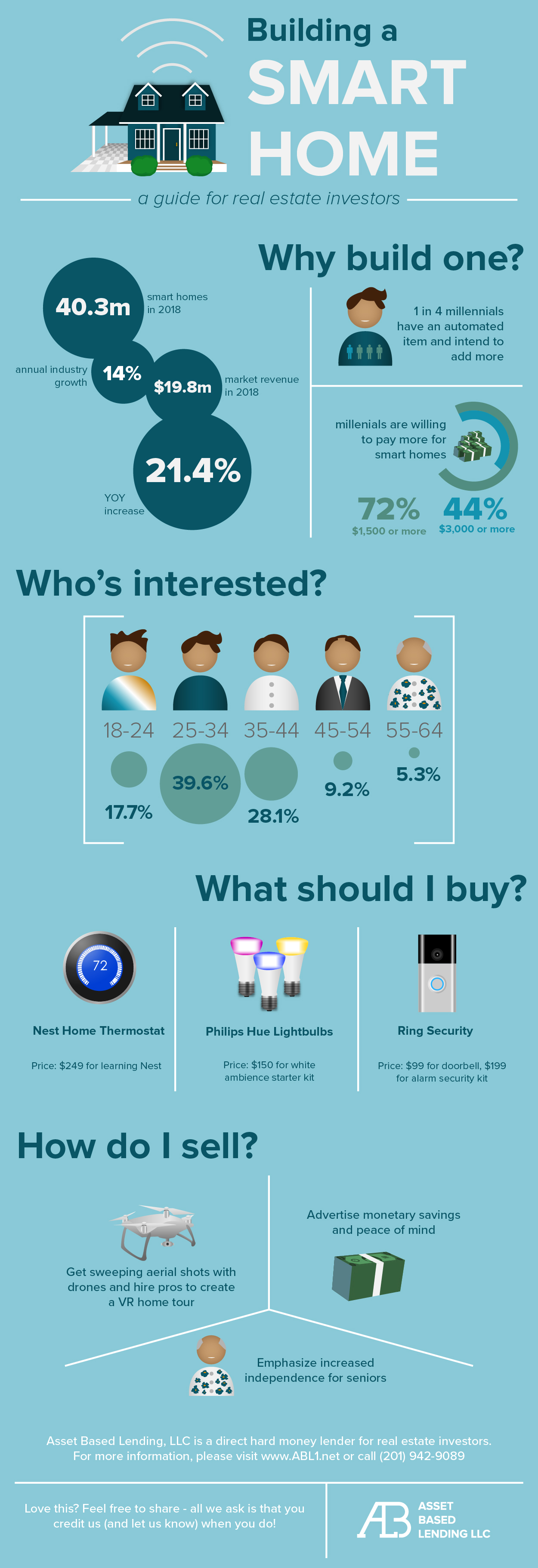Although smart tech is not yet expected in homes on the market, that shouldn’t deter you from making your next investment property smart enabled. Once upon a time, energy-efficient dishwashers and A/C were also considered luxuries in homes. Today, they are the standard.
Why Build a Smart Home?
By developing a house that is compatible with smart tech and including some pre-installed smart amenities, you can boost your profit potential and make your listing stand out. In 2014, 36% of builders reported increased profit potential by installing home theater pre-wiring or systems, 26% by installing monitored security, and 23% with structured wiring. As tech becomes more integrated with our day-to-day lives, the profit potential of installing smart systems – or at least wiring for them – is likely to go up.
It is reasonable that these upgrades increased the builders’ profit potentials, based on a survey of millennials that suggested 72% would pay $1,500 or more and 44% would pay $3,000 or more to make a home smart – no small price, especially considering the fact that many popular smart devices cost between $100 and $300 dollars. You could outfit a home with smart temperature regulation, lighting, and a full security system – as well as add a control device like Amazon Alexa or Google Home – for less than $1,000.
Another survey showed that 25% of millennials have at least one automated item and intend to add more to their household; additionally, 45% of all Americans have or plan to purchase at least one home automation product. The most popular products manage lighting, home security, and temperature.
As of the latest 2018 stats, there are currently 40.3m smart homes in America – a 21.4% year over year increase from 2017. The smart home industry is projected to grow between 14.9% and 17% in the coming years; by 2022, experts predict that smart tech will have a market volume of $34.6MM and 53.1% household penetration.
How To Build a Smart Home System
Pre-Wire for WiFi
Today, many builders and fix and flip investors are pre-wiring new construction for WiFi. Thinking about how and where consumers will use smart tech in a house allows builders to design wiring structures that eliminate dead spots and broadband overloads. Additionally, when renovating your fix & flip, be sure to install plenty of outlets with standard plugs, USB chargers, and Ethernet ports to accommodate all types of devices.
Design an Open Floor Plan
Keep the floor plan open so homeowners can minimize the number of command centers they need for house-wide connectivity. The more closed doors and walls, the more command devices they need to ensure that their instructions are heard from any location.
Choose Smart Devices Carefully
The market has a lot of big names in each domain of smart tech and you should research the pros and cons of different devices before choosing which to install. It is also wise to refrain from purchasing items that largely rely on personal preference.
For example, one device you should not purchase for your buyer is the home command system. With Amazon, Google, and Apple all offering smart home hubs, it is impossible to predict which option the future owner will prefer. Some of the best new hubs even come from outside of these three big names – Wink and Samsung both offer highly-rated central control devices. You can choose a hub to set up as a demo – and maybe even offer to throw it in for free if the buyers are hedging on the price – but a command device is best chosen by the actual owners.
Since it’s not clear what the ultimate financial benefit will be, you don’t want to over-invest in smart infrastructure. The most established benefit of smart tech is that it helps move homes faster. For example, according to Redfin, smart homes in Malibu California sold 61 days faster than the area’s average last year.
To make the home smart without drastically increasing your budget, focus on creating the most utility with the devices you choose. One or two luxury smart items, such as a hidden TV or a voice-lighted mirror in the bathroom, can help your home stand out, but be weary of overspending. Expensive features like smart refrigerators and laundry appliances are often prohibitively expensive and not as in-demand as basic features like lighting, security, and temperature control.
Popular Smart Home Devices
Three of the most in-demand – and affordable – smart features are the Nest learning thermostat, the Ring video doorbell, and the Philips Hue smart lights.
Nest Learning Thermostat
The Nest Learning Thermostat connects with your smartphone and learns your habits so that when you are away from home, it saves energy by increasing or decreasing the ambient temperature. Nest learns your temperature habits: if you turn the temperature down before you go to sleep a few days in a row, Nest will automatically shift the temperature setting around the time you typically head to bed. If you tend to turn up the temperature when you wake, the device will turn on the heat while you eat breakfast. You don’t even need to be home to adjust the temperature – you can do it remotely with the Nest app.
This device saves your time and reduces your energy bill; an independent study found that Nest reduced heating costs by 10%-12% and cooling costs by 15%. Because of its impact on home energy use, Nest is the first ENERGY STAR certified thermostat. The device costs $249 and generally pays for itself in two years.
Ring Video Doorbell and Security
Ring started out with their popular smart doorbell and soon expanded into the general smart security industry. They now sell a variety of video doorbells, security cameras, and security systems – all of which can be controlled from the same app.
Starting at $99.99, the doorbell notifies you when someone is at your door and lets you speak with the visitor through the device – whether you are home or not. The Ring Alarm is $199 and comes with a base station, keypad, contact sensor for doors or windows, a motion detector, and a range extender so your base system can reach farther in your house. You can get notifications when someone comes to the door, when someone opens a window or door, and when there is motion inside of your house. Security-conscious buyers can expand the system after they purchase the home with Ring cameras, starting at $199, and view live footage of their property.
Philips Hue Lights
Since you likely need to purchase light bulbs anyway, you can splurge a little on the Philips Hue lights in select rooms like the bedroom and den. Show potential buyers how simple it is to control the lights – they can use a smartphone to turn the lights off easily from bed or completely darken the den when they’re about to put on a family movie.
Hue offers three different bulb options for your home: white, white ambiance, and white and color ambiance. For your smart home investment purposes, all you really need is the Philips Hue White starter kit and perhaps a few extra bulbs. The starter kit is $99.99 and comes with four bulbs and a bridge for light management which will allow the owners to manage future bulb purchases, as well.
If you leave home and forget to turn the lights off – or are away and want to make it seem like you are home – you can switch them on or off remotely from a smartphone app. Additionally, you can set timers so your lights automatically turn on when you come home and turn off when you leave and dim the lights from the app or with voice commands to an Amazon Alexa, Apple HomeKit, or Google Home.
Risks of Smart Home Design
While smart house design is becoming more prevalent and appreciated, there are still pockets of the market that are opposed to intense modernization. If buyers are looking for a traditional home, smart features will likely clash with the old-timey charm of your investment property and turn off old-fashioned buyers.
Additionally, there are so many different smart features that you may unintentionally cross the chasm between novelty and utility and end up spending cash you won’t recoup. Novel smart features will not have high returns in the same way that useful smart features do because less buyers expect them. Let the owners splurge on self-cooking and cleaning robots; focus on setting up a basic smart home interior design so that they can incorporate more niche tech later.
Marketing Your Smart Home
Focus on tech-savvy consumers
Most likely, the type of buyer who is interested in a smart home and willing to pay more for the amenities is already involved with advanced tech. To catch this tech-savvy buyer’s attention, focus on professional-looking video marketing for the best results. To get sweeping shots of the exterior of your property, consider hiring a videographer who works with drones. Drones can take beautiful shots of the lawn and neighborhood that an on-the-ground cameraman just can’t get.
Additionally, consider hiring a professional team to create a VR home walkthrough marketing video. This 3D walkthrough can serve both as a standard home walkthrough video for non-VR consumers but will have the added benefit of allowing individuals who already own VR headsets – and are therefore more interested in modern tech – to gain a unique visual perspective of your home.
Set up smart features in advance
When customers buy the home, they may need to reset the devices to connect them to their own phones, tablets, or command centers; however, you still want to set the features up with your own device first so that you can demonstrate the full home capabilities to potential buyers. If realtors are showing your home, make sure that they are aware of how to control your smart home features and have access to the command device for the best sales pitch.
Market to seniors
Comprising only 5.3% of the smart tech market, the 55-to-64-year-old crowd may not be as comfortable with home automation as their younger counterparts, but that doesn’t mean you should forgo marketing to this age group. Adults over 64 – who don’t even purchase enough smart tech to make it onto the market share list – have much to gain from home automation. For younger and middle-aged adults, it may be convenient to control the A/C, lighting, and home security while lounging on the couch, but it’s generally not a necessity; however, many older adults have limited mobility and need a better way to control the house if they want to continue living on their own into old age.
If you are targeting retirees with your investment projects, installing useful smart devices can give your property a leg up over the competition. Advertise the increased independence that comes with a smart home for the elderly – they can purchase and control devices to clean the house, monitor the home security, and adjust lighting and temperature controls, all from a single device like an iPad or a smart command center. If they have cash to spend, they can even purchase smart devices that cook dinner, wash and fold clothes, and feed pets automatically.
While smart homes are considered a luxury today, smart device market penetration increases every year. Home tech is improving, and inventors are constantly thinking of ways to make homeowners’ lives easier. As an investor, taking advantage of the low prices of simple and popular smart devices can provide an extra draw for buyers, offer more amenities to advertise your home, and increase the final sale price.
Are you ready to get started?
Asset Based Lending is a local hard money lender in New York, New Jersey, Florida, Maryland, Massachusetts, Connecticut, and Pennsylvania. If you’re looking for funding for a real estate investment opportunity in one of these states, fill out an online prequalification form to see what ABL can do for you.








0 Comments